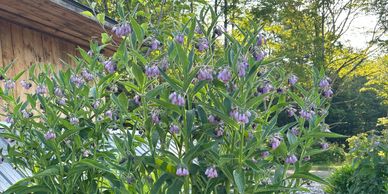My Favorite Plants
Comfrey
Elderberry
Elderberry

Comfrey is the workhorse of the garden. This perennial is a powerful soil builder and fertilizer, beloved by pollinators, blooms all summer long, and generally behaves itself and stays put. This is a Bocking 14 cultivar that has sterile seeds. Cut down several times during the summer and use the cuttings to mulch and fertilize beds. I plant it around all my fruit trees and other permanent plantings to provide a continuous and balanced supply of nitrogen, potassium and phosphorous. I also use it to make a nutritious compost tea and steep dried leaves in organic olive oil for a comfrey oil that I use daily on my face and mix with beeswax and scent with lavender for an amazing salve. $18 for healthy, field-grown divisions in spring and fall.
Elderberry
Elderberry
Elderberry

Elderberry grows well in full sun to partial shade and is a fast-growing shrub that reaches 12-15 feet. Pruning can control its height and degree of shrubbiness. It flowers around June in my garden with bounteous, fragrant, and useful flower clusters. It spreads through rhizomes and is very hardy and easy to grow. It can be a stand-alone plant or make a great privacy hedge or windbreak. I use it to make elderflower cordial and elderberry syrup and jelly. Elderberries are a rich source of vitamins C and B6, iron and antioxidants and are commonly used to fight colds and flu. Make sure you cook them! Raw berries will make you sick and don’t taste good. The plant grows best in moist, well-drained soils but is thriving in my heavy clay soil. Bare root plants are available once foliage has died back and plant is dormant in the fall and spring for $22 for a gallon sized plant or $38 for a larger shrub.
Rhubarb
Elderberry
Garden Visits

Rhubarb is another workhouse in my garden. While comfrey is hard at work weeding and feeding, rhubarb guards the perimeter of my garden beds to make sure lawn and other weeds stay in their lane! I have been dividing rhubarb plants and extending the line so that it runs the entire length of my garden that touches on lawn. As a result, do I ever have rhubarb!!! Rhubarb likes full or nearly full sun and prefers well-drained, fertile soil rich in organic matter. But it is a tough plant that will grow anywhere, including my heavy clay beds, but I keep adding organic matter and they do love it. Space plants 4’ apart because they will grow. It’s big leaves shade out even the sneakiest weeds. Any weeds that makes it through are weak and easy to pull. I make rhubarb juice, jam, pie and crisps. I frequently mix rhubarb with berries to add flavor and extend my berries when a recipe calls for berries. I use the leaves to mulch between plants and further deter weeds. The deer do not like this so it’s doubly good as a defense line. Depending on the weather, rhubarb can be harvested in May and June. A bout of heat will generally make stalks tougher less edible - eat it in season and freeze liberally! I used to deadhead the flowers religiously to keep the rhubarb from putting energy into seeds instead of stalks. But because I have so much, I now wait to cut the flowers until they are starting to go by as the pollinators LOVE them. Plants are available spring and fall for $16 and fresh rhubarb in season for at market price.
Garden Visits
Garden Visits
Garden Visits

If you’d like to see firsthand the place our plants and animals call home, please be in touch to schedule a visit.
Contact Us
Garden Visits
Contact Us

Have questions about the farm? Contact us today and we'll be happy to help. You can reach us by phone, email, or by filling out the form on our website. We look forward to hearing from you!
